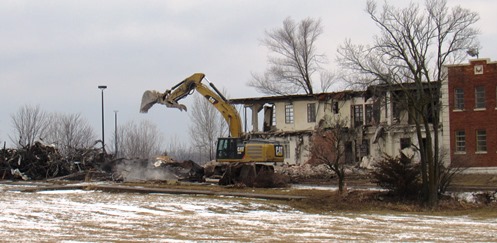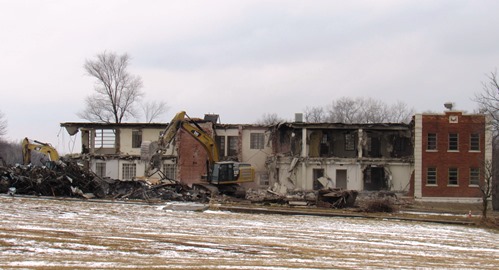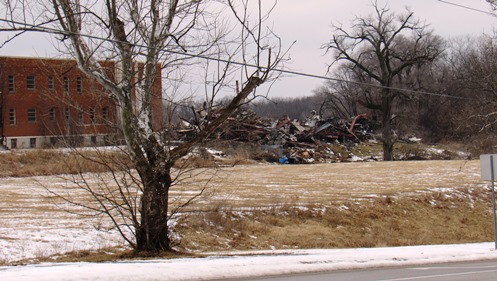


Editor’s note: The former Wyandotte County Courthouse Annex at 94th and State Avenue, and the surrounding area, was the subject of several news stories in 2007. One of them from the Wyandotte West on Feb. 6, 2007, is reprinted below:
Boundaries of county annex cemetery determined
by Mary Rupert
More than 500 graves, mostly unmarked and unremembered, sit on the east side of the Wyandotte County Courthouse Annex property.
The annex at 94th and State Avenue, once a home and farm for the county’s poor, also contains a burial ground on county property for the indigent.
The graves were the site of an extensive investigation last year, in preparation for turning the property between 94th and 98th Streets over to the Schlitterbahn water park development, and before road improvements were made on 94th Street. As part of the agreement, the graves will not be moved.
“The gravesites are not to be touched,” Bob Roddy, Unified Government assistant county administrator, said last week. “They’re going to remain as is.”
Roddy said the county found old records describing where some of the unmarked gravesites were located, and field investigation was done to discover where other graves were located. Metal detectors were used to locate the perimeters of the burial grounds and some probing was done along the edges.
Noninvasive measures were used to discover gravesites.
“We’re extremely sensitive to it,” Roddy said. “The decision was made early that we weren’t going to disturb the graves.”
The issue of placing some sort of marker on the cemetery could be discussed in the future, he said.
The geophysicist hired by the Unified Government to explore the area has published a report on it, and has given a talk about it at a scientific conference in December in St. Louis, Mo. The lead archaeological investigator was Chris Schoen of the Louis Berger Group of Marion, Iowa.
In his report, geophysicist Geoffrey Jones of Minneapolis, Minn., noted that the cemetery was established in 1870 and was used until 1973. The number of total burials there is unknown, but 541 burials were recorded during the last quarter century of the cemetery’s use, the report stated.
The cemetery had an iron gate and a chain link fence at its entrance, but otherwise, its boundaries were not known, according to Jones’ report. Only two of the graves were marked.
The researchers used noninvasive geophysical techniques, including electrical resistance and magnetic gradiometer surveys, of parts of the cemetery, Jones reported. Archaeological techniques also were used.
The researchers concluded the cemetery was limited to the interior of the road loop and to the flat hilltop between the road loop and 94th Street. Another area containing burials was on higher ground between the eastern road of the cemetery and 94th Street, according to the report.
They used backhoes to strip 11 nearby areas that were unlikely to contain graves, according to the report. In those areas, 31 burials were identified, the report stated.
The older part of the cemetery contained shroud burials, while the newer portion contained wooden coffins, the report noted.
A lawsuit filed by a Wyandotte County resident to stop the annex from being torn down because of its historic value is still pending, according to Ken Moore, Unified Government attorney. He said he had not heard anything new about the lawsuit since Judge Muriel Harris stated last year that she could not hear it because she had a conflict of interest. Her husband serves on the Wyandotte County Fair Board. At the time the board was considering the property as a site for the county fair.
The Wyandotte County Fair Board has since approved a plan to hold the county fair at a temporary site at The Woodlands this year, although a permanent site has not yet been announced. County offices have already moved from the courthouse annex to other locations.
Roddy said he expects an announcement about activity to take place at the Schlitterbahn site within the next two to three months.

Total BS this is a disgrace to Kansas. This building is part of our history. Shame on all of you for what you’re doing. I’m sick of the greed people have. It’s obviously very old , I’m so ashamed of the Kansas Government.
There is nothing off limits to the glut in government. SHAME ON ALL OF YOU
I agree that this is a disgrace. I am very sad ? ? ?
Nancy Reynolds:
There is some information in a file concerning the “Pauper’s Cemetery” in the WYCO Museum Archives. Call (913) 573-5002. Ask for Jeff. He is very knowledgable about all cemeteries in Wyandotte County.
Is there a list of names of the people that are buried there.
Desecration.
Thanks for the inclusion of the article from February 6, 2007. Seems that nothing is sacred – especially the graves of the poor. Here’s a link to Geophysicist Geoffrey Jones’ “The Wyandotte County Cemetary: a case study in geophysical assessment of historic cemetaries”. http://www.archaeophysics.com/pubs/wy-cem.html
Do read the first paragraph under “Cultural and physical contexts”.
To Whom It May Concern:
Following up on the Wyandotte Daily News 2021 re-print of a 2007 story on the status of the “Pauper’s Cemetery”, the UG of Wyandptte County/Kansas City, Kansas has a responsibility to advise the public of the 2021 status of this public cemetery where many of our indigent citizens were buried.
Likewise, the plan for preserving and respecting this site in perpetuity, with major new development planned on all sides of it, should be explained to the public in the news media. Any citizens who have relatives buried in the Pauper’s Cemetery should speak up.
I was vice president and historian for the Wyandotte County Historical Society and Museum when this issue came up during the former Schilltterbahn Development in 2007 Residents and the UG have a responsibility to update the status of this issue.
Thank you!
Joe Vaughan
So sad. Loved that historical building. Too bad it couldn’t have been integrated into new plans so we could still enjoy it.
Sadly the poor are usually treated the worst during their lives, and apparently it continues into death. So disrespectful! It also looks like this will ruin the greenspace that surrounds the houses in this area!!
Good point! Could our UG fence in the entire area, keep it mowed, and then put up a Historical Monument with a few lines of history. All this in a spot where you could drive up to read it? Maybe it’s already in the plans.
I worked for the UG for 22 years and I agree it should have been considered an historical building, but don’t forget the UG sold the land to Schlitterbahn, so they lost their voice when they sold the property, we should have complained when the sold it.
I moved to KCK in 1972 to start working for the Wyandotte County welfare office. We had an annex in the back portion of the building. I was shocked to see it torn down.